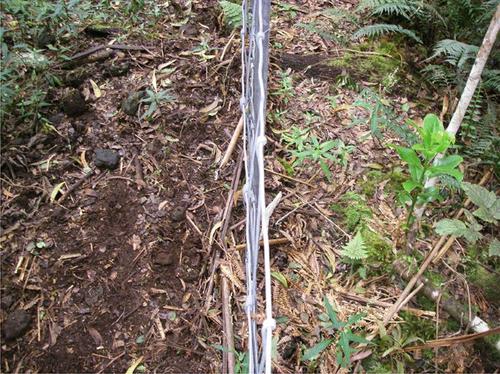Biogeochemistry ( IF 4 ) Pub Date : 2024-03-24 , DOI: 10.1007/s10533-024-01120-8 Fiona M. Soper , Kimberlee S. Sparks , Rebecca J. Cole , Christian P. Giardina , Creighton M. Litton , Jed P. Sparks

|
Non-native ungulates (sheep, goats, and pigs) have significant negative impacts on ecosystem biodiversity, structure, and biogeochemical function throughout the Pacific Islands. Elevated nitrogen (N) availability associated with ungulate disturbance has been shown to promote the success of resource-exploitive invasive plants. While ungulate removal is a common restoration intervention, evaluations of its efficacy typically focus on vegetation responses, rather than underlying nutrient cycling. We used multiple chronosequences of ungulate exclusion (10–24 years duration) in three Hawaiian ecosystems (montane wet forest, dry forest, and dry shrubland) to determine N cycle recovery by characterizing gross mineralization and nitrification, soil inorganic N concentrations and leaching, N2O emissions, and plant tissue δ15N. Ungulate removal led to a 1–2 ‰ decline in foliar δ15N in most species, consistent with a long-term decrease in N fractionation via ecosystem N losses, or a shift in the relative turnover of N forms. This interpretation was supported by significant (dry forest) or trending (wet forest) increases in mineralization and decreases in nitrification, but conflicts with lack of observed change in inorganic N pool sizes or gaseous losses, and increased leaching in the dry forest. While results could indicate that ungulate invasions do not strongly impact N cycling in the first place (no uninvaded control sites exist in Hawai’i to test this hypothesis), this would be inconsistent with observations from other sites globally. Instead, impacts may be spatially patchy across the landscape, or ungulate invasions (possibly in combination with other disturbances) may have permanently shifted biogeochemical function or decoupled elemental cycles. We conclude that eliminating ungulate disturbance alone may not achieve restoration goals related to N cycling within the timeframe examined here.
中文翻译:

三个热带岛屿生态系统中野生有蹄类动物清除后氮循环的恢复不一致
非本地有蹄类动物(绵羊、山羊和猪)对整个太平洋岛屿的生态系统生物多样性、结构和生物地球化学功能具有重大负面影响。与有蹄类动物干扰相关的氮(N)可用性升高已被证明可以促进资源开发型入侵植物的成功。虽然去除有蹄类动物是一种常见的恢复干预措施,但对其功效的评估通常侧重于植被反应,而不是潜在的养分循环。我们在三个夏威夷生态系统(山地湿森林、干燥森林和干燥灌木丛)中使用了有蹄类动物排斥的多个时间序列(持续 10-24 年),通过表征总矿化和硝化、土壤无机氮浓度和淋滤、氮2 O 排放量和植物组织 δ 15 N。有蹄类动物的去除导致大多数物种的叶 δ 15 N下降 1–2 ‰ ,这与生态系统氮损失导致的氮分馏的长期减少一致,或者是N 种形式的相对周转率。这种解释得到了矿化显着(干燥森林)或趋势(湿润森林)增加和硝化作用减少的支持,但与缺乏观察到的无机氮库大小或气体损失的变化以及干燥森林淋滤增加相冲突。虽然结果可能表明有蹄类动物的入侵一开始并没有强烈影响氮循环(夏威夷不存在未入侵的对照地点来检验这一假设),但这与全球其他地点的观察结果不一致。相反,整个景观的影响可能在空间上是斑驳的,或者有蹄类动物的入侵(可能与其他干扰相结合)可能会永久改变生物地球化学功能或解耦元素循环。我们的结论是,仅消除有蹄类动物的干扰可能无法在此处检查的时间范围内实现与氮循环相关的恢复目标。



























 京公网安备 11010802027423号
京公网安备 11010802027423号